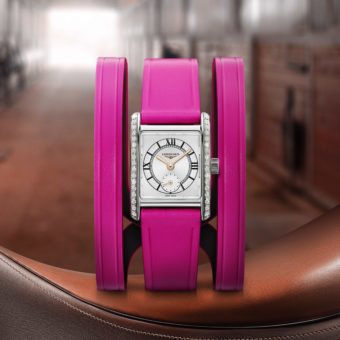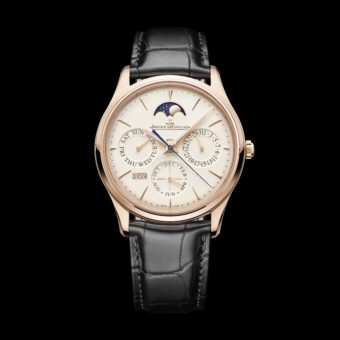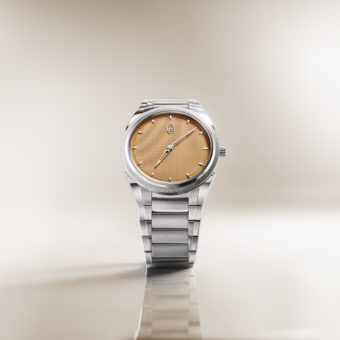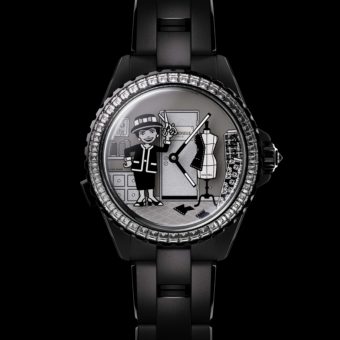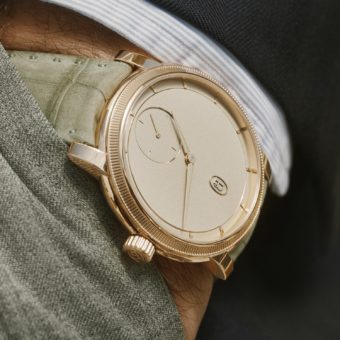That same year, 2006, Raffy learned that the Château de Môtiers, which dates from the 13th century, was for sale. The château is located in Môtiers, next to Fleurier, and stands atop a wooded hill overlooking Fleurier. The appeal for Raffy was that it once belonged to the Bovet family. He purchased it in 2007. After extensive renovations, it opened in 2008 and houses a watchmaking workshop with 20 employees. It will eventually become the headquarters of the Bovet firm. It marks the realization of Raffy’s dream to return Bovet to its roots in Val-de-Travers.
Today Raffy’s Bovet 1822 Group produces 2,000 watches a year, ranging in price from $12,500 to $900,000. The core brand is Bovet 1822, which comes in two collections, Fleurier and Sportster. Typical of the Fleurier collection of complicated watches is the new Complications 47 mm, a watch featuring two of what Bovet calls its “star” complications, the tourbillon and jumping hour. It contains Bovet’s own self-winding, seven-day tourbillon movement (Caliber 13BA05 made by Dimier). It has a number of distinctive Bovet features: a tourbillon cage in the shape of a lotus blossom, the Bovet corporate emblem; serpentine hands on the subdials; and the Fleurier-style decoration (called fleurisanne) of engraved bridges. Bovet will produce 50 pieces: prices are $195,000 for the rose-gold model and $199,000 for the white-gold one. Bovet also creates one-of-a-kind pieces, with enamel dials, in the Fleurier collection.
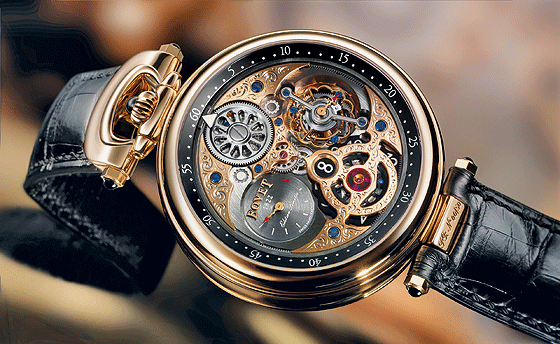
The Sportster collection, as the name implies, is for Bovet’s sportier designs. New this year are Sportster Saguaro chronographs with meteorite dials ($19,800 to $39,500). Bovet also introduced a tourbillon into the Sportster line this year. The Saguaro Tourbillon has an 18k-rose-gold case with black PVD titanium inserts on the side and a rubber strap. The tourbillion movement is the in-house Caliber 13BA05. The watch comes in three sizes: 40-, 45- and 51-mm, priced from $140,000 to $151,000.
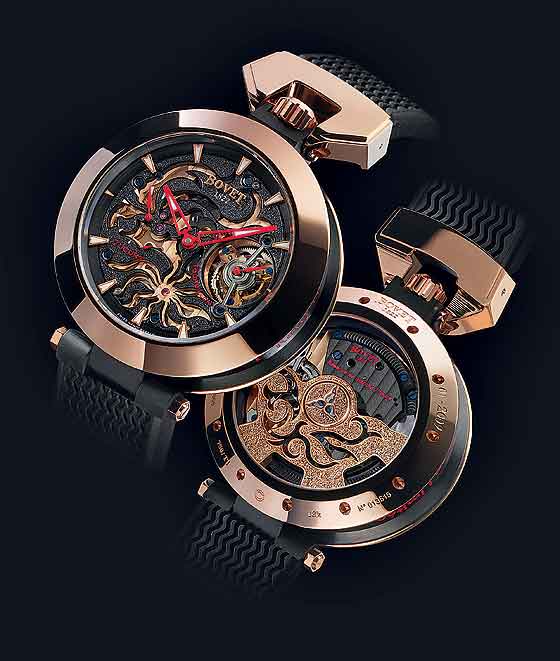
In 2007, Raffy introduced a second brand called Dimier, consisting of highly complicated limited-edition pieces with the crown in the traditional position at 3 o’clock. The company introduces one new Dimier piece a year under the name Recital. The 2009 watch, Recital 3, is the Orbis Mundi, a mechanical self-winding tourbillon with seven-day power-reserve and world timer with 24 cities indicated. It’s priced at about $200,000 for rose gold and $210,000 for white gold.
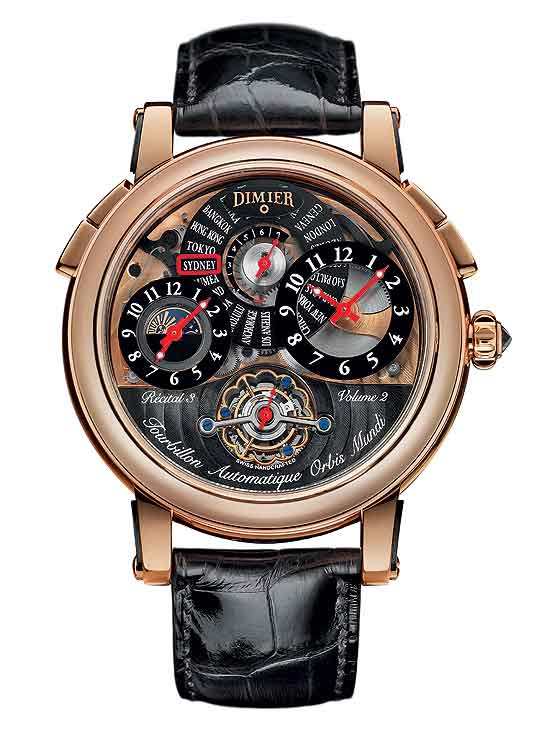
In developing products, Raffy relies on his own good taste. His collection consists exclusively of watches that appeal to him personally and that he would wear himself. In addition to classical men’s models with cases measuring 39, 42 or 44 mm in diameter, Raffy developed Bovet chronographs with two or three counters and big date displays, plus a moon-phase display and a hand-type calendar indicator. Other complications included a perpetual calendar, a minute repeater, a tourbillon and a jumping hour.

Some Bovet watches are equipped with one of the world’s most beautiful mechanical movements: Piguet’s 12½-ligne Caliber FP 71 with micro-rotor. Others contain automatic Caliber Vaucher 331, made in the manufacture that Michel Parmigiani established in Fleurier. (The old Vaucher firm had manufactured for the original Bovet brand in the 19th century.) Onto these calibers, Agenor in Geneva adds complication modules, like those for jumping hours and perpetual calendars. Christophe Claret of Le Locle delivers complicated movements with minute repetition and/or butterfly-shaped tourbillons. Bovet inverts Claret’s repeater movement so that the tourbillon and the hammer that strikes the gongs are both visible through the watch’s crystal.
Many Bovet watches boast special enamel painting, engraving and/or embellishment with gemstones or pearls. The seemingly sober cases are free of superfluous frills, yet they’re highly recognizable thanks to their pocket-watch geometry. Genuine pearls or diamonds serve as hour indices on some models. The tradition of enameling (cloisonné or miniature painting) continues to be cultivated on the dials, which are decorated with historical scenes or depictions drawn from modern life. For watches with moon-phase displays, a golden disk that seems to float in a sky made of lapis lazuli symbolizes the moon. Another distinctive feature of a Bovet watch is serpentine hands. Even on Bovet sports watches, at least one hand is serpentine-shaped.
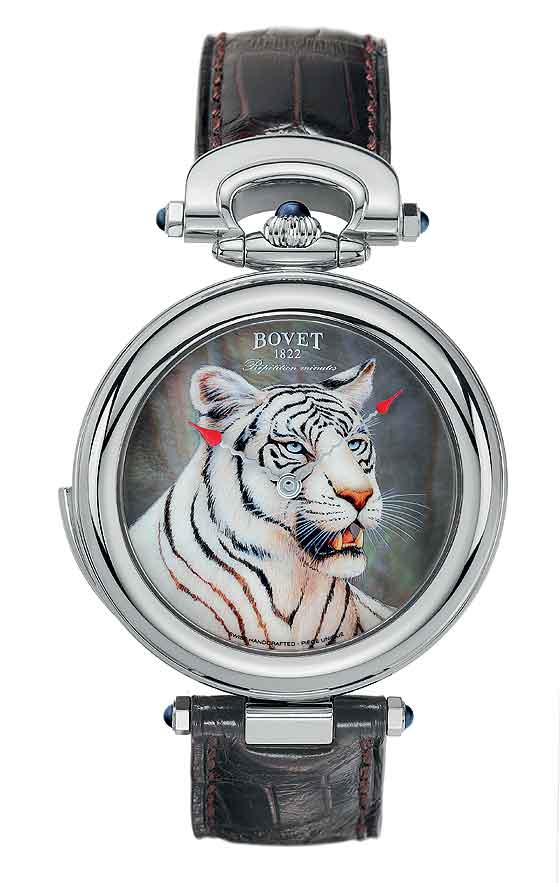
Bovet pays enormous attention to its dials. It purchases the finest quality mother-of-pearl in 0.3-millimeter-thick disks, which are then lacquered with the desired color and pasted onto sheet gold. An in-house artist paints this nacreous surface in accord with each customer’s specifications before the miniature artwork is fired in a kiln. Several layers of colored lacquer are then applied, allowed to harden, and given a high-gloss polish. The final step is to drill a hole in the center of the disk for the staff that bears the hands.
All Bovet metal dials are domed: they’re made of gold, which is then either given galvanic treatment to create silver plating or painted with enamel. Cloisonné enamel is used for special items: golden bars prevent the variously hued glass powders from intermingling during the firing process, thus keeping the individually colored fields separated from one another. Bovet sometimes inserts diamonds into the cloisonné. The brand also cultivates the art of classical enamel painting: motifs are often painted in mirror-image pairs, just as they were during Bovet’s Chinese period.
Raffy clearly has raised the image and quality of the Bovet brand. He is keeping a tight rein on production, which will not exceed 2,000 pieces per year, he says.


